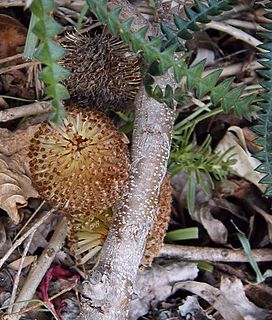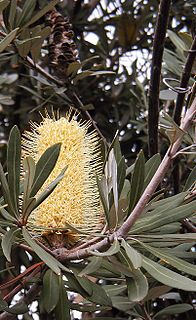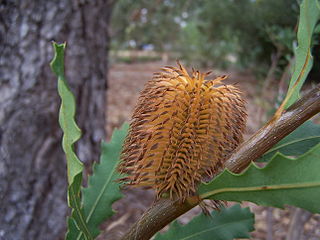
Banksia subg. Isostylis is a subgenus of Banksia. It contains three closely related species, all of which occur only in Southwest Western Australia. Members of subgenus Isostylis have dome-shaped flower heads that are superficially similar to those of B. ser. Dryandra, but structurally more like reduced versions of the "flower spikes" characteristic of most other Banksia taxa.

Banksia burdettii, commonly known as Burdett's banksia, is a species of shrub or tree of the genus Banksia in the family Proteaceae. It occurs on sandplain country north of Gingin, Western Australia. Growing to 4 m (13 ft) in height, it has long serrated leaves and large, bright flower spikes, initially white before opening to a bright orange, that appear mainly in late summer. Edmund Gilbert Baker described B. burdettii in 1934, naming it after its collector, W. Burdett.

Banksia nutans, commonly known as nodding banksia, is a species of shrub native to the south coast of Western Australia in the genus Banksia. Growing to a metre (3 ft) tall, it has pale blue-green fine-leaved foliage and unusual purple-brown inflorescences which hang upside down rather than grow upright like most other banksias.

Banksia plagiocarpa, commonly known as the Dallachy's banksia or blue banksia, is a species of shrub or tree in the plant genus Banksia. It occurs only on Hinchinbrook Island, Queensland and the immediately adjacent mainland. First collected in 1867, Banksia plagiocarpa was not described until 1981, when Alex George named it in his monograph of the genus Banksia. Genetic studies show it to be related to Banksia aquilonia, Banksia oblongifolia and Banksia robur.

Banksia praemorsa, commonly known as the cut-leaf banksia, is a species of shrub or tree in the plant genus Banksia. It occurs in a few isolated populations on the south coast of Western Australia between Albany and Cape Riche.

Banksia saxicola, the rock banksia or Grampians banksia, is a species of tree or shrub in the plant genus Banksia. It occurs in Victoria in two distinct populations, one in The Grampians and the other on Wilsons Promontory. Formerly considered to be a form of B. integrifolia, it was described as a distinct species by Alex George in 1981. It is most closely related to Banksia marginata.

Banksia ser. Dryandroideae is a taxonomic series in the plant genus Banksia. First published by Carl Meissner in 1856, the name has had two circumscriptions. As presently circumscribed it is monotypic, containing only B. dryandroides.

Banksia ser. Abietinae is a valid botanic name for a series of Banksia. First published by Carl Meissner in 1856, the name has had three circumscriptions.

Banksia ser. Salicinae is a valid botanic name for a series of Banksia. First published by Carl Meissner in 1856, the name has had three circumscriptions.

Banksia ser. Quercinae is a valid botanic name for a series of Banksia. First published by Carl Meissner in 1856, the name has had three circumscriptions.

Banksia ser. Cyrtostylis is a taxonomic series within the plant genus Banksia. First published at sectional rank by George Bentham in 1870, it was demoted to a series by Alex George in 1981. The name has had three circumscriptions.

Banksia ser. Banksia is a valid botanic name for a series of Banksia. As an autonym, it necessarily contains the type species of Banksia, B. serrata. Within this constraint, however, there have been various circumscriptions.

Banksia spinulosa var. spinulosa is a shrub that grows along the east coast of Australia, in Queensland and New South Wales.

Banksia subser. Longistyles is a valid botanic name for a subseries of Banksia. It was published by Kevin Thiele in 1996, but discarded by Alex George in 1999.

Banksia subser. Leptophyllae is a valid botanic name for a subseries of Banksia. It was published by Kevin Thiele in 1996, but discarded by Alex George in 1999.

Banksia subser. Sphaerocarpae is a valid botanic name for a subseries of Banksia. It was published by Kevin Thiele in 1996, but discarded by Alex George in 1999.

Banksia ser. Ochraceae is a valid botanic name for a taxonomic series within the plant genus Banksia. It was published by Kevin Thiele in 1996, but discarded by Alex George in 1999.

Banksia subser. Banksia is a valid botanic name for a subseries of Banksia. It was first used by Kevin Thiele in 1996, although as an autonym it is not considered to have been published per se. It was discarded by Alex George in 1999.

Banksia subser. Cratistylis is a valid botanic name for a subseries of Banksia. It was first published by Kevin Thiele in 1996 but discarded by Alex George in 1999.
Dryandra ser. Capitellatae is an obsolete series within the former genus Dryandra. It was published by Alex George in 1996, but discarded in 2007 when Austin Mast and Kevin Thiele sank Dryandra into Banksia.

















